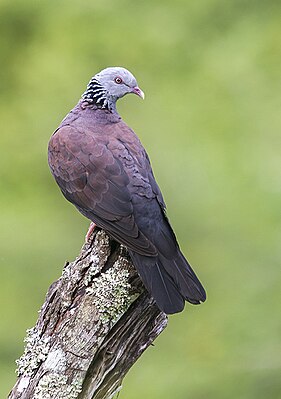Nilgirite Dove
| Nilgirite Dove | ||||||||||
|---|---|---|---|---|---|---|---|---|---|---|

Nilgirite Dove, Kerala |
||||||||||
| Systematics | ||||||||||
|
||||||||||
| Scientific name | ||||||||||
| Columba elphinstonii | ||||||||||
| ( Sykes , 1832) |
The Nilgiri dove ( Columba elphinstonii ), also known as the Nilgiri wood dove or neck pigeon , is a species of pigeon birds. It occurs exclusively on the Indian subcontinent. The population situation of the Nilgiritube is given as vulnerable ("endangered").
features
The Nilgirita dove reaches a body length of 42 centimeters and is thus something as big as a city pigeon , but it has a somewhat less compact physique. It weighs around 380 grams. There is no pronounced gender dimorphism .
In the male, the head is pale gray. The forehead and the ear covers are a little lighter than the crown. On the sides of the neck and on the back of the neck there are stiffened black feathers, which have narrow violet or greenish-shiny hems and a white feather tip on the outer flags. This creates a wide, slightly shimmering, white spotted collar. The coat, the back and the rump are brownish. The flight feathers are black-brown. The upper tail-coverts are blackish, the upper side of the tail is dark gray.
The chin and throat are pale gray, the chest is the same color but has a faint green tinge. The rest of the underside of the body is gray and becomes darker on the flanks and in the direction of the under tail-coverts. The under tail-coverts are black-gray. The beak is yellowish green with a red beak base. The iris is yellow-brown to gray-brown. The feet are reddish with gray-white claws.
The female is a little more dull in color than the male. In the young birds, the collar is not so pronounced, a large part of the feathers of the body plumage still has narrow chestnut-brown edges.
Possible confusion
In the distribution area of the Nilgiritaube there are several other types of pigeons that can be confused with it.
The bronze fruit pigeon is slightly larger and has wider, more rounded wings. There is only a possibility of confusion with young birds of the Nilgiri pigeon, as these are still missing the iridescent plumage that makes the Nilgiri pigeon unmistakable from this type of large fruit pigeon . The mountain fruit pigeon ( Ducula badia ) is distinguished by the broad brown-gray end band on the control feathers. The pearl- necked pigeon has a similar collar to the Nilgirite dove, but is much smaller and the elytra are lightly scaled. The oriental turtle dove is also significantly smaller and has a wine-reddish body underside.
Distribution area and habitat
The Nilgirite Dove is a species of bird found in southwestern India. It occurs there from the hill country of the Western Ghats and the west of Tamil Nadu to the south of Maharashtra . It inhabits mountainous deciduous forests in this area. It is considered a rare bird in the entire distribution area.
Way of life
The Nilgiri dove is a shy pigeon that usually lives solitary or in pairs. Smaller clusters only occur when a single tree bears abundant fruit. The Nilgirite dove lives on fruits, berries and buds. It mainly eats in the treetops, but occasionally comes to the ground to look for fallen fruit. It is basically a resident bird, but depending on the food supply it moves around small areas.
The breeding season falls from March to July. The nest is built high in trees or in bushes. The clutch consists of a single egg.
Nilgiri doves and people
Dedication names
The specific epithet honors Mountstuart Elphinstone (1779-1859), a senior executive of the East India Company and later British diplomat at various Indian royal courts. He was the British Governor of Bombay from 1819 to 1827. After 1827 he was offered the office of Governor General and Viceroy of India twice, but for health reasons he had to give up this office on both occasions.
attitude
Nilgirite doves were first shown in Europe in 1964 at London Zoo . Offspring are not yet known (as of 1996).
literature
- David Gibbs, Eustace Barnes and John Cox: Pigeons and Doves - A Guide to the Pigeons and Doves of the World. Pica Press, Sussex 2001, ISBN 90-74345-26-3 .
- Alois Münst and Josef Wolters: Pigeons - The types of wild pigeons. 2nd, expanded and revised edition. Karin Wolters Verlag, Bottrop 1999, ISBN 3-9801504-9-6 .
- Gerhard Rösler: The wild pigeons of the earth - free living, keeping and breeding. Verlag M. & H. Schaper, Alfeld Hannover 1996, ISBN 3-7944-0184-0 .
Web links
- Columba elphinstonii in the endangered Red List species the IUCN 2012. Posted by: BirdLife International, 2012. Accessed October 17, 2016th
Individual evidence
- ↑ Columba elphinstonii in the endangered Red List species the IUCN 2012. Posted by: BirdLife International, 2012. Accessed October 17, 2016th
- ↑ a b Gibbs, Barnes and Cox: Pigeons and Doves , p. 200.
- ↑ a b Gibbs, Barnes and Cox: Pigeons and Doves. P. 201.
- ↑ Bo Beolens, Michael Watkins: Whose Bird? Men and Women Commemorated in the Common Names of Birds . Christopher Helm, London 2003, ISBN 0-7136-6647-1 , pp. 205 .
- ↑ Rösler: The wild pigeons of the earth. P. 92.

